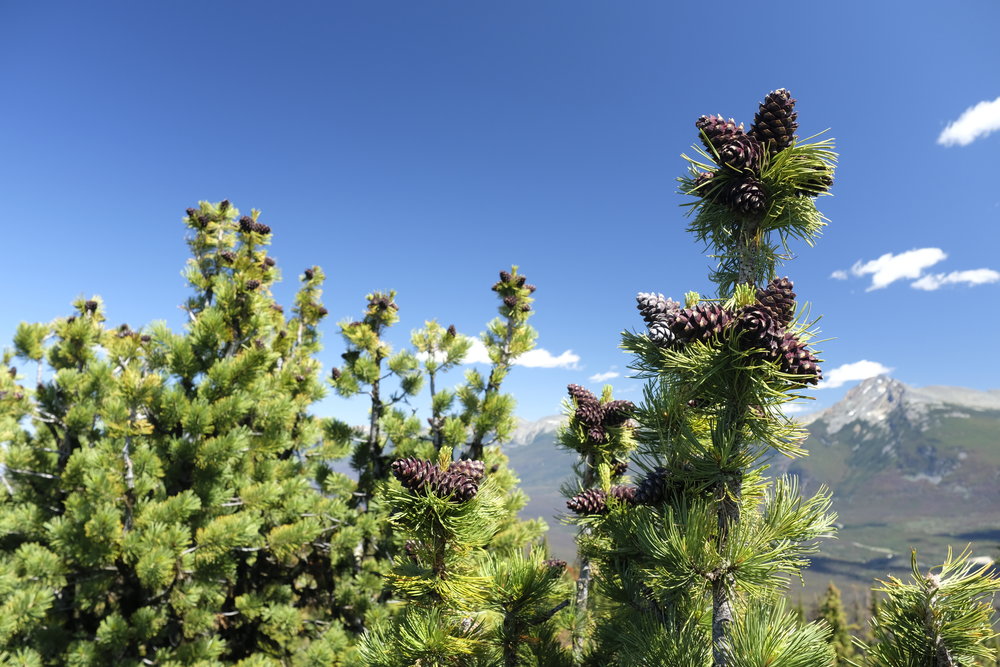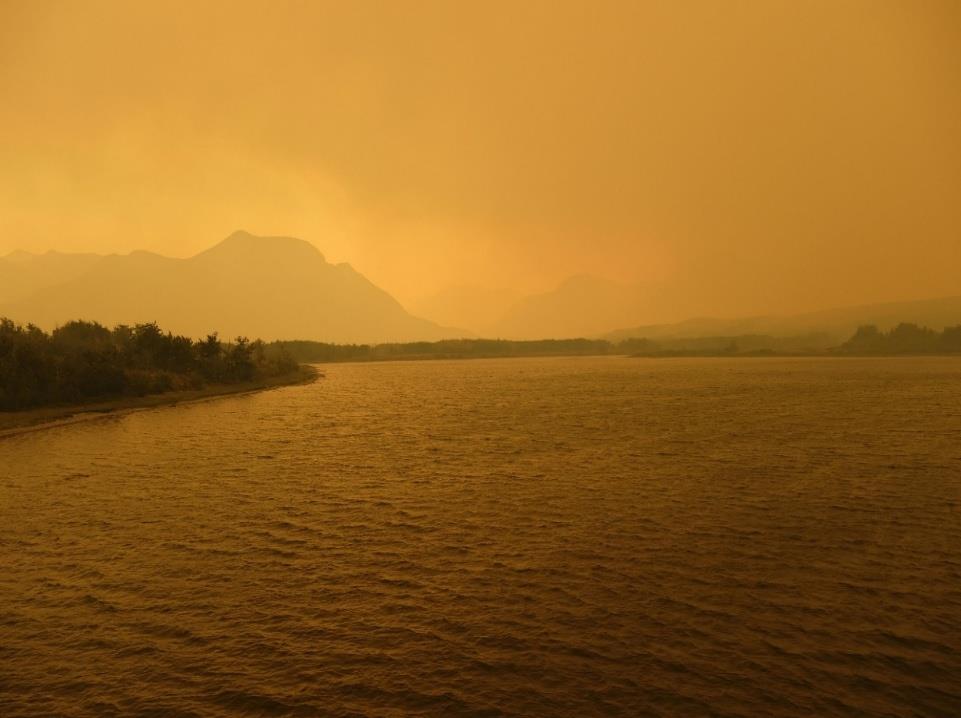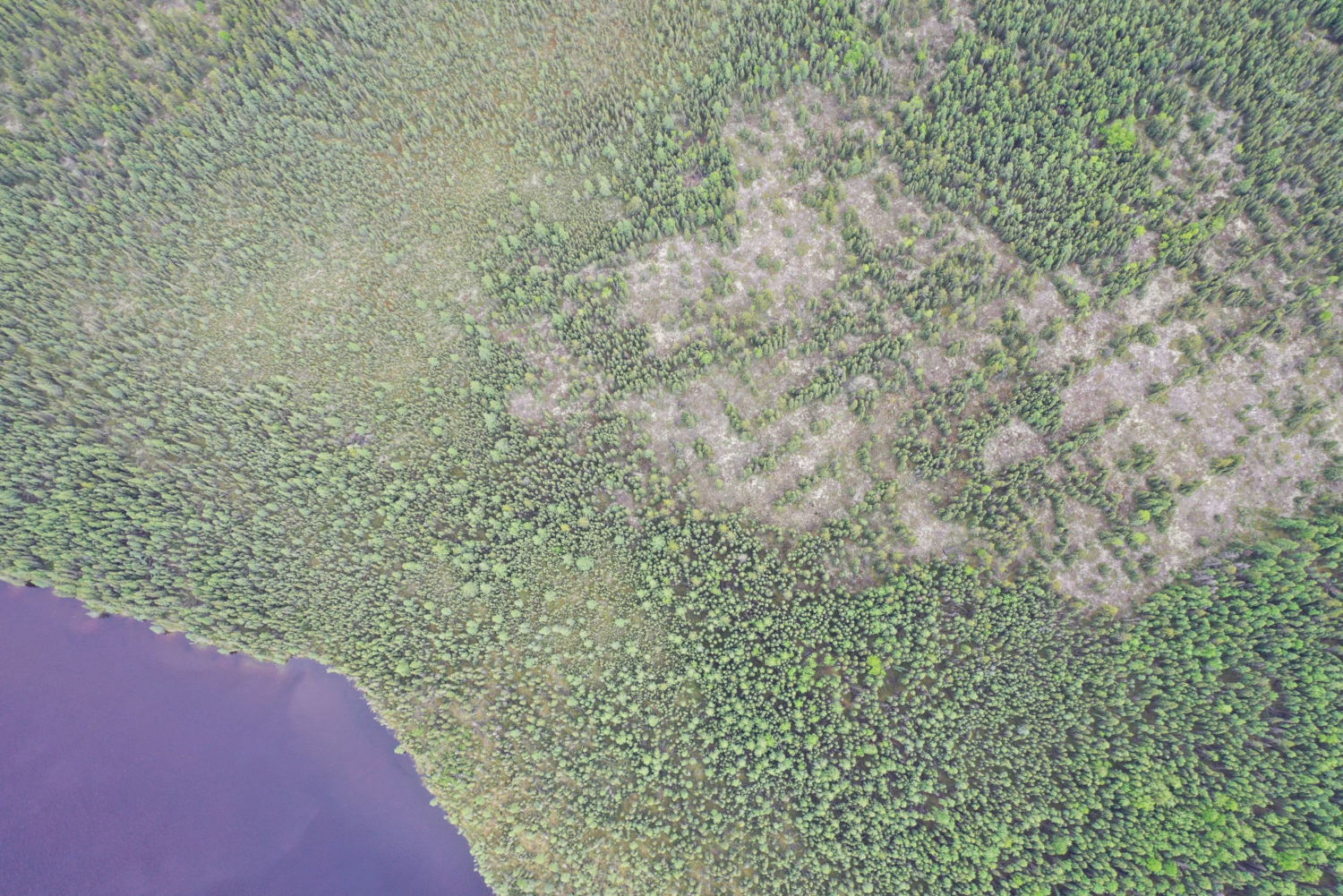Ancient but Vulnerable
Alberta's Endangered Pines
There is something amazing and valuable about extremely long-lived species, partly because they so dwarf the scale of our own existence that they realign our perception of what is normal. Like the pioneers of our great-grandparent’s generation, they make lives for themselves in extremely harsh conditions and a distinctly slower paced world. Although many people understand in an abstract sense that somewhere there are trees that can live for unimaginably long times, few seem aware that they can be found right here at home, and that they are facing extinction. Some of Alberta's longest lived and most charismatic trees are critically threatened by an imported fungus, and they may not survive it.

Endangered whitebark pine cones at the top of a healthy tree.
Endangered whitebark pine cones at the top of a plus tree.

The Kenow wildfire, hours before crossing Waterton National Park.
The Kenow wildfire, hours before crossing Waterton National Park.
These trees are the whitebark and limber pines, often known as ‘five needle pines’ because they have five needles per cluster - more familiar Alberta pines have two. Young trees often have a beautiful smooth, silvery bark, almost reminiscent of an aspen tree, and extremely distinctive cones. Limber cones are very large, attractive, and wonderfully scented, while whitebark cones are an unexpected brilliant purple color. Both trees are gorgeous not only in isolation, but also as a part of their natural landscape – leaning precariously out over hilltops and outcrops in the foothills and Rocky Mountains. They grow extremely slowly, take nearly a hundred years to reproduce, and can live for over a thousand years, meaning that the oldest of them may have germinated shortly after the Vikings first explored North America.

Endangered whitebark pine cones at the top of a plus tree.
Far more than a striking part of the scenery, these trees are a vital part of the environment, providing a vital food source for birds, bears, and other animals. Their seeds are far higher in fat and protein than other trees, and in many parts of their range they are by far the most nutritious food source available to wildlife and birds. They are so important that their influence ripples outward throughout the mountains and foothills, sustaining entire ecosystems. But one of the most valuable services they provide, from our perspective, comes from their high elevation habitat.
Trees in the high mountains are few and far between, and many of them are five needle pines. Their presence here holds onto the snowpack and moderates the release of water, making both drought and flooding less likely downstream. It's a subtle benefit, and difficult to quantify, but it may become more and more important as the climate warms. It is possible that, without the five needle pines to govern the high snowpacks, wildfires like the ones that devastated Fort McMurray and Waterton will be harder to prevent and fight, and floods will become more and more severe.

The Waterton National Park fire, hours before it ravaged the park.
It is often difficult to explain to the public why something like the five needle pines is worth saving, but parts of Alberta are already tremendously proud of them. In the Crowsnest Pass area of Southern Alberta the ‘Burmis Tree’, a gnarled and skeletal old dead limber pine, practically symbolizes the area and is represented in many artworks and local businesses nearby. These endangered pines are beginning to capture the public imagination and become important tourism and cultural symbols.
The Crowsnest Pass area of Southern Alberta contains one of the largest remaining populations of limber pines in Canada and is home to the Burmis Tree, a historic limber pine.
The Crowsnest Pass area of Southern Alberta contains one of the largest remaining populations of limber pines in Canada and is home to the Burmis Tree, a historic limber pine.
Although they are clearly tenacious and resilient, five needle pines have a devastating weakness – a non-native fungus known as a rust, which is spreading throughout the province and threatens them with extinction. As so often happens, because the pines have no historical exposure to the rust, they have almost no resistance to it. It infects trees by growing through their needles and causing swollen, devastating cankers. Because these infections are rich in sugars, animals chew on them, causing deep, weeping wounds that eventually kill the tree.
A gnarled and skeletal old limber pine in the Crowsnest Pass. The rust has been so devastating that landowners and ranchers sometimes think that this is what a limber pine should look like.
A gnarled and skeletal old limber pine in the Crowsnest Pass. The rust has been so devastating that landowners and ranchers sometimes think that this is what a limber pine should look like.
The rust is so virulent that in the hardest hit parts of the province nearly all the trees are infected or dead. Nearly - but not quite. Every now and then, around a corner or nestled in a little gully surrounded by its dead fellows, you may stumble upon a tree that seems untouched. This tree is a ‘plus tree’ – if you’re lucky, it may have genetic resistance to the rust. Only one limber pine with complete resistance is known yet from Alberta, and none of the far more vulnerable whitebarks have demonstrated it yet. Finding these trees is the only way to save the five needle pines from extinction.
A truly unique limber pine. This tree is at least five hundred years old and has been blown over by a massive wind storm in recent decades, but has continued growing.
A truly unique limber pine. This tree is at least five hundred years old and has been blown over by a massive wind storm in recent decades, but has continued growing.
But one tree with limited resistance is not nearly enough to repopulate a species, and finding more of them is extremely challenging - in two years, I have helped assess the health of tens of thousands of trees. For every plus tree, two or three hundred others are deemed too sick. Not including in parks, there are under two hundred known plus trees in the entire province. And every year, more of them are disqualified by developing new infections, or lost to wildfires. In some areas, over half of the known plus trees developed new infections this year that made them much less compelling as possibly resistant trees.
Once a tree has been located, and its health thoroughly assessed, its cones are caged to prevent animals and birds from eating the seed. The cages must be collected as late in the fall as possible to allow the seed to mature. But because of their high, exposed habitat, waiting this long can often be risky. A record snowfall in early October this year dropped over half a metre overnight in some of the areas we needed to visit, isolating over half of our caged trees. We eventually collected all of them, but the snow made our work much more challenging and exhausting.

Beautiful patterns in snow after a record snowfall in the Crowsnest Pass that complicated cone collections immensely.
Beautiful patterns in snow after a record snowfall in the Crowsnest Pass that complicated cone collections immensely.
The seeds collected from these very special trees are germinated, and the seedlings are exposed to a high dose of rust spores. Any genetic resistance will be detected through a higher survival than the general population, and the original trees can then hopefully be used to help restore devastated populations throughout Alberta.

Whitebark pine seeds from a hopefully resistant tree in the Kananaskis. These seeds, if the parent tree is indeed resistant, may help save the species.
Whitebark pine seeds from a hopefully resistant tree in the Kananaskis. These seeds, if the parent tree is indeed resistant, may help save the species.
Clearly, the five needle pine story is a challenging ecological problem, but unlike most similar conservation crises, the public is uniquely poised to help. There are likely millions of five needle pines throughout the province that have never been assessed for rust, and some of them will certainly be plus trees. Hundreds of ranchers, farmers, hunters, landowners, and hikers pass them by every day in the foothills and Rocky Mountains, and could dramatically assist with the effort to locate healthy trees in areas of very high rust. In doing so, they may help ensure that these iconic and ancient trees will survive.

An article about the remote Yukon research camp 'Pika Camp', and the climate change work I assisted with there.
An article about the remote Yukon research camp 'Pika Camp', and the climate change work I assisted with there.

An article about my most recent work, an expedition to find the first globally imperiled 'alvar' habitats in Saskatchewan.
An article about my most recent work, an expedition to find the first globally imperiled 'alvar' habitats in Saskatchewan.